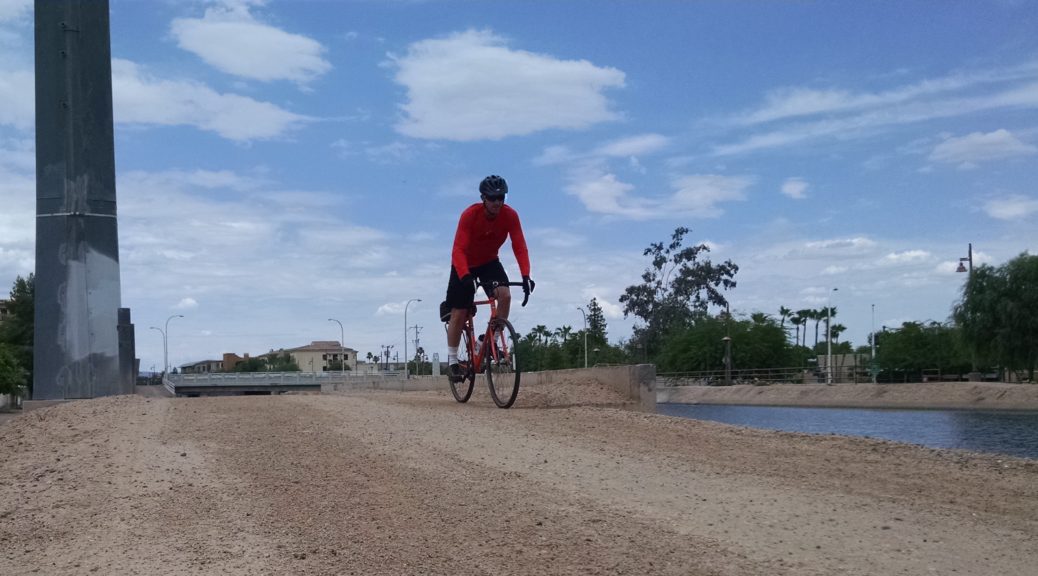5 July 2015, Day 14 Without a Job
It’s the day after the 4th of July. I’m here in Scottsdale with Andrew Haines. We rode our bikes to breakfast yesterday and I’ve been inspired to write about something I’ve been meaning to for a while. Scottsdale has some great dedicated bike paths, especially along the canals.
I’m working on an idea–that might already exist–and I’m calling it “commuter cyclocross.” If it does already exist, great, but it is not widespread enough. It should be mainstream. It solves so many problems for so many normal people!
How many working professionals want to bicycle, but say, “I don’t have time,” or “The roads are too dangerous.” A lot of people use these 2 excuses to not ride the expensive bikes that are in their garages with tires that have slowly deflated since they last rode several months ago.
The opposite end of the spectrum is hard-core cyclists who claim to enjoy sitting for hours on a seat made of carbon fiber that’s barely larger than the end of the post it’s attached to. They ride 60+ miles at a time, often in a big circle, and often on two-lane highways ignoring the fact that there are cars and trucks whizzing by at 55+ miles per hour. Let’s not forget the weeny little tires that go flat from gravel or a little broken glass. Last, but not least, the spandex shorts. Really? Wind resistance is a big deal, I understand, I’ve experienced it, but aren’t you trying to get a work-out anyway? You are just alienating regular people who are now in their cars sending text messages, swearing at you, and almost hitting you. Put on some regular shorts and be an ambassador for the activity!
Neither of the above situations appeals to me. I consider myself a “cyclocross commuter.” Cyclocross commuting entails the full end of the spectrum from beginning to end of using your bike as a tool to travel from point A to point B. That is, after all, the purpose of a bike! Your goal as a cyclocross commuter is to replace your automobile as much as possible with your bike. The advantages are many. You simultaneously:
Advantages
- Save fuel.
- Transform driving, traffic, and road rage–often the most stressful part of a typical office worker’s day–into light aerobic exercise that makes you feel good.
- Eliminate the daily trip to the gym goal that is another stress-causing item on your daily checklist.
- Learn your area from a totally different perspective than from the confining seat of your car.
- There are more. What are they?
There are challenges, but that’s all part of the fun.
Challenges
- You show up to work all sweaty. True, but your employer would rather you show up sweaty and happy than out of shape and stressed! Bring a full change of clothes (including your wet, nasty underwear of course) and get yourself a locker at work. You can put on those nasty clothes for your ride home. Who cares what you smell like then.
- You’ll have to eat significantly more food. Eating enough can become a challenge. If your workplace is far enough away, you can forget about dieting. Your new problem will be eating enough to keep weight on! You’ll spend more on food, but that’s alright, you saved that money on gas.
- It’s dangerous. I agree, it can be. That’s why I go to great lengths to avoid highways, two-lane roads, and especially those BS bike paths made of only paint that just entice cyclists out into dangerous traffic. Are they trying to kill people? Paint is not going to protect me from a car. Oh, but there are signs that tell motorists to watch for cyclists! No thanks. I’m not getting getting someone’s radiator jammed up my rear over a text message. Cities are competing with each other like Pepsi vs. Coke to build dedicated bike paths. Use them!
- You have to travel at night. There’s less traffic, it’s cooler, and with all the money you save on your gym membership and gas, you can get some pretty cool lights. You can’t have too many blinky red lights on your back. One on your helmet, one on your shirt, one on your bike and one on your bag. Redundancy!
- There are more challenges. What are they?
Cyclocross Commuting, The Checklist
- Get a versatile bike. I recommend starting by clicking here for the Ultimate Commuter Bike.
- Pick your most common trips of the day / week / month that are under about 15 miles one-way.
- Get on Google Earth or Google Maps and make your route. In the comfort of your home, find a way around the most dangerous parts. Where there aren’t dedicated bike paths, learn neighborhood streets. Find good places to stop for food and water.
- Pick a day when you have time and can afford to be late when you run into issues along the route. Expect the first ride to be frustrating.
- After your first ride, learn from it. Adjust your route. Go shopping for gear that will make it easier. Bags, lights, rain gear, you name it: you aren’t the first person to have the problem and somebody has already made a product to deal with it.
- Try again next week. The logistics get easier each time!
Alright, I’ve convinced Andrew to go riding in the July Arizona heat. I don’t want to disappoint! Our mission: grocery shopping, church, and get pictures for this post!
Great cyclocross commuter products:
Expensive shorts, but worth it. Find them on sale somewhere:
Carry your stuff without wearing a back-pack:
